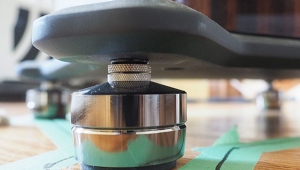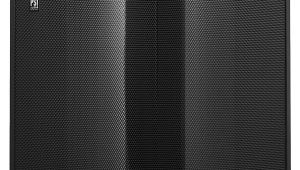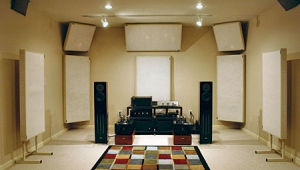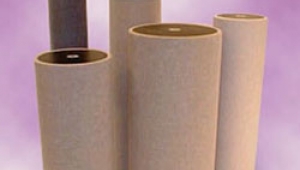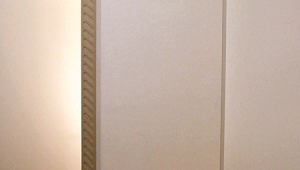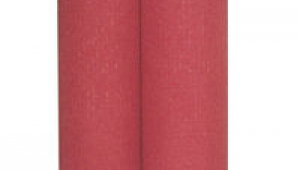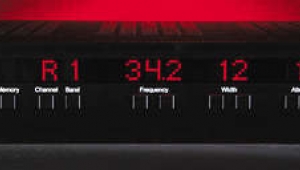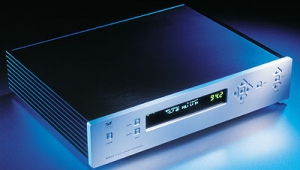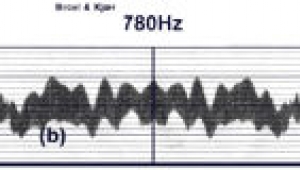| Columns Retired Columns & Blogs |
Phantom Acoustics Shadow active low-frequency acoustic control Page 2
This concept is far from new. Olson and May, in a 1953 Journal of the Acoustical Society of America paper, described a system called a "free field zone type sound reducer." It consisted of a microphone, amplifier, and loudspeaker set in a loop to define an acoustic region of low pressure. They further described mounting the device in the room corners to maximize its effect by presenting it with the large acoustic load present there.
Footnote 2: After reading an advance copy of this review, Phantom Acoustics notified us that they had increased the Shadows' retail price from $1790/pair to $2500/pair—a nearly 40% increase. Despite Phantom Acoustics' assertion that this price increase had been contemplated for nearly a year, the decision to substantially raise the price concurrent with publication of a rave review seems opportunistic. The price increase is unfortunate; it means that fewer audiophiles will be able to enjoy the benefits of this remarkable product.
When a room is pressurized by sound, the pressure is not evenly distributed throughout the room. Instead, high-pressure zones are created along most of the walls, especially the corners. The greatest pressure buildup that supports room-resonance modes occurs where three boundaries (two walls and ceiling or floor) meet. This gives us an opportunity to attack excessive low-frequency problems where they live: absorbers placed in the corners are much more effective than absorbers away from the walls.
The Shadow consists of a tall, round column and an outboard power supply. The 7'-tall column is mounted on a base and covered with a light-colored fabric. In fact, the Shadow looks very much like a tall Tube Trap. Transducers mounted at the top and bottom of each column provide the out-of-phase acoustic energy, while the bulk of the column is internally damped. I was surprised at how lightweight the column was for its size and the fact that it contains two amplifiers and two transducers.
The power supply is a small black box with an AC power-cord input and a DC-supply output. A front-panel switch (with a corresponding LED) turns the unit on. Switching on the power causes the column to emit a quiet turn-on thump.
Incidentally, the Shadow was developed by Nelson Pass, President of Threshold Corporation and designer of, among other things, the Threshold and Fort;ae lines of electronics.
The Sound
I have just finished building a dedicated room for music listening and component reviewing. The final acoustic treatments (diffusors and low-frequency absorbers) are not yet installed, making the room ideal for assessing the sonic attributes of the Phantom Acoustics Shadow. Without any low-frequency absorption, my room suffers from a common malady: uncontrolled room modes, lopsided absorption, and a longer decay time at low frequencies.
A Shadow was placed in each corner behind the speakers. This placement brings the Shadow's transducers closest to the tri-corners, where pressure buildup is greatest. The Shadows' AC cords were plugged in to a power strip near my listening chair, making it easy to turn the units on and off for comparison. In addition to disabling the units by turning them off, I removed them from the room to eliminate such passive effects as mid-frequency absorption and diffusion. Because they are designed to work in pairs, both Shadows were treated as one system. All with/without comparisons were made by turning off both units simultaneously.
Since this was the first music I had heard in the new listening room, I spent some time listening with Vortex Screens before conducting any evaluations. I have logged about 2000 hours with the Screens in many rooms and am intimately familiar with their sound; this gave me a feel for the room's sound before introducing another variable. It was immediately apparent that the room was significantly better than previous rooms that had hosted the Screens. The room's dimensions had been chosen for best distribution of resonant modes. (In fact, the entire house's dimensions were dictated by the listening-room ratios).
After becoming acclimatized to the sound, I switched in the Shadows. I was listening to "Twiggs Approved," from the Dixie Dregs' album Dregs of the Earth, which has a very powerful low end. The change was startling. The entire tonal character of the bottom end changed for the better. Low bass sounded deeper and more powerful, while the midbass seemed thinner, probably due to the attenuation of resonant colorations. In addition, the bass drum sounded lower in pitch and lost its unpleasant wooden character, and bass guitar suddenly had more detail and clarity.
The instant I heard this, I was reminded of something I had experienced in the recording studio many times before. When recording bass drum, a common method of increasing punch and removing tubbiness is to use the recording console's EQ, boosting at 60Hz and cutting at about 400Hz. After finding the right EQ settings, the EQ in/out switch is pressed to compare the flat sound with equalized sound. The sonic effect of switching on the Shadows was very similar to applying this equalization to a bass drum. In addition, this equalization makes "room" for the bass guitar, giving it a clearer tonal character and greater rhythmic impact. The Shadows' apparent lowering of the bass drum's pitch is probably a result of removal of resonant modes that tend to obscure the instrument's lowest component.
In addition to increasing LF punch, midbass articulation improved. On acoustic and electric bass, each note was delineated and clearly audible—the effect was analogous to pulling taut a trampoline. The entire low-frequency range became tight and solid. Gone was the sluggishness that homogenizes bass notes. Without the Shadows, certain bass notes were accentuated as the room's modes were excited. Repeating the same passage with the Shadows dramatically demonstrated the gross colorations introduced by the room when resonances were not suppressed. The Shadow did not completely eliminate standing waves, however. Moving around the room revealed changes in LF amplitude indicative of standing waves, although amplitude changes were diminished.
Not all music is affected equally by the Shadow. Its effects vary from dramatic (as described above) to inaudible, depending on the music's low-frequency content. For the Shadow to be audible, the program must contain frequencies that excite the room's resonant modes. This implies that the deeper the speaker's LF extension and the more bass energy they can deliver into the room, the greater the improvement provided by the Shadow. Indeed, solo female voice and solo acoustic guitar did not benefit from the Shadow.
To test the other side of this hypothesis, I connected the TDL Reference Standard Loudspeaker, a huge transmission-line system rated down to 16Hz. The TDL's ability to pressurize a room with very-low-frequency energy at high sound-pressure levels is astounding. I put on the Dorian CD of Pictures at an Exhibition (DOR-90117), transcribed for organ and performed by Jean Guillou on the organ of the Tonhalle, Zürich. This is an exceptional recording, both musically and sonically. Pictures calls for extensive use of the instrument's lower registers, and the organ, designed by Guillou, has 32' pipes that produce a 16Hz fundamental. My expectation that the Shadows' beneficial effects would be more pronounced on music with substantial LF content was confirmed with this recording. Through the bi-amped TDLs with the Shadows activated, I heard the deepest and most articulate bass reproduction I had ever experienced.
Measurements
Playing the swept tone on the CBS test disc revealed the severe room colorations caused by resonance modes. As the pitch sweeps up, the amplitude varies greatly as the signal passes through room modes. Using an Audio Control Industrial SA-3050A third-octave spectrum analyzer, I measured the LF amplitude in third-octave bands with and without the Shadow. Turning on the Shadow resulted in a much smoother curve, both visually on the spectrum analyzer display, and audibly. The reduction in resonance peaks varied greatly, depending on the analyzer's microphone position and frequency. The greatest reduction was 5dB at some frequencies. Room resonant peaks are certainly greater in amplitude than 5dB, but the third-octave resolution may not be sufficient to look at such narrow bands.
Conclusion
Before listening to the Shadows, I was concerned about introducing devices into the listening room that created their own acoustic signal. What if their acoustic output wasn't exactly out of phase with the music? Could such an active device cause a whole new set of problems? However, after auditioning the Shadows at length, I must conclude that their contribution was nothing but beneficial.
The Shadows' improvements in low-frequency definition, dynamic impact, and LF tonal neutrality were dramatic. They allowed bass to be heard without the smearing and loss of articulation we have come to accept as normal. Only by hearing the Shadows' effects can the untreated room's severe colorations be fully realized. Indeed, I was subsequently dissatisfied listening to music without the Shadows, as this resulted in lower-octave reproduction that severely detracted from the musical experience.
I should reiterate that the Shadows' sonic improvements vary greatly depending on the LF output of the loudspeakers and the bass content of the program. Music with a light spectral balance, devoid of frequencies that excite room resonant modes, did not benefit from the Shadows. Moreover, mini-monitors, lacking the ability to pressurize the room, realized little improvement from the Shadows. Through speakers with good LF extension, full-scale orchestral works, nearly all rock, and most jazz, the improvement was truly rewarding. I found myself exploring my record and CD collection as though for the first time, amazed at what had been previously obscured. There is something very musically satisfying about being washed in powerful, accurate bass reproduction.
I suspect that the Shadow may provide a greater sonic improvement in rooms without ideal length:width:height ratios. Remember, my room's dimensions were chosen for the most even modal distribution. Rooms with equal dimensions or multiples of a dimension will have much more severe colorations and thus will benefit more from the Shadow.
The trend toward treating the listening room as another component in the signal path is long overdue. Only by hearing the lowermost octaves reproduced correctly can the room's contribution to the playback chain be realized. The Phantom Acoustics Shadow is a significant advancement in home listening-room treatment. I highly recommend that you audition it, in your listening room if possible. After spending some time with the Shadow and your record collection, you may find it an essential component of your music system (footnote 2).
Footnote 2: After reading an advance copy of this review, Phantom Acoustics notified us that they had increased the Shadows' retail price from $1790/pair to $2500/pair—a nearly 40% increase. Despite Phantom Acoustics' assertion that this price increase had been contemplated for nearly a year, the decision to substantially raise the price concurrent with publication of a rave review seems opportunistic. The price increase is unfortunate; it means that fewer audiophiles will be able to enjoy the benefits of this remarkable product.
- Log in or register to post comments
